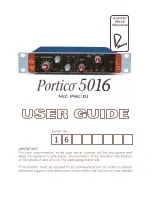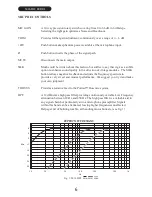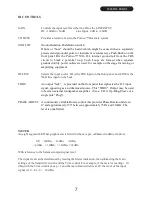
5016 MIC PRE/DI
5
DESIGN NOTES
In former years, before the introduction of solid state amplifiers, transformers were necessary to
step up to the very high input impedance of tubes, and to provide a balanced input for the
microphone line. An input impedance of 1,000 or 1,200 ohms became established for microphones
having a source impedance of 150 or 200 ohms, with connection being made on a twisted twin
screened cable (
This type of cable, while excellent for low impedance work, has high capacitance
between its conductors and between each conductor and screen. Resultant high frequency losses
are excessive with piezo pickups and may cause resonances with magnetic pickups)
Thus
microphones were not heavily loaded. Condenser microphones worked off high voltage supplies
(300V!) on the studio floor which polarized the diaphragms and powered a built-in pre-amplifier.
More and more microphones were needed as “Pop” music gained ground and this led to the popular
and efficient method of 48-volt “Phantom” powering that was built into the multi-channel recording
Console – in place of numerous bulky supplies littering the studio, a miniature pre-amplifier now
being fitted inside the microphone casing.
The 48-volt supply was fed to the microphone through balancing resistors so it was impossible for
this voltage to actually reach the microphone, resulting in low polarizing volts and virtual
starvation of the little pre-amp inside the microphone. Nevertheless amazingly good microphones
were designed and made, becoming the familiar product we use today.
If a low value resistive load is connected to the output of an amplifier, that amplifier has to produce
power in order to maintain a voltage across that load. Obviously if we want more voltage (output
from the microphone) we need to provide a larger supply for the amplifier or settle for a lighter
load.
A microphone is a voltage generator, not a power amplifier. Most microphones give their most
accurate performance when they are not loaded by the input impedance of a traditional
preamplifier.
If the microphone uses an electronic circuit (transformerless) output, a low value of load impedance
will likely stress the little microphone pre-amplifier, causing slew rate and compression at high
levels.
On the other hand, a high value of load impedance allows the microphone to “breathe” and give of
its best, this being particularly advantageous with very high level percussive sounds.
If the microphone has an inductive source (such as would be the case if it has a transformer output)
a low value of load impedance causes the high frequencies to roll off due to leakage inductance in
the transformer in addition to the above amplifier distortion (This can be an advantage with some
microphones!).
For this reason I have provided a high value of input impedance that will load microphones to the
smallest possible extent and makes the best possible use of that limited “Phantom” 48-volts supply.
Содержание Portico 5016
Страница 1: ......













